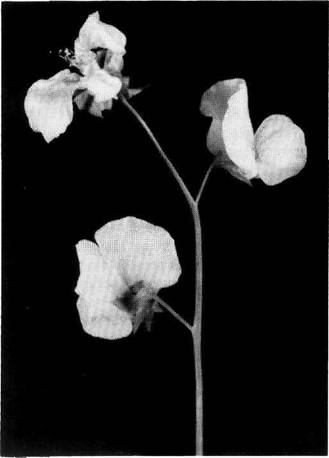
|
Pisum Genetics |
Volume 25 |
1993 |
Research Reports |
pages 15-16 |
Floral abnormalities in the fasciated line G38E
|
Ambrose, M.J. |
John Innes Institute, Colney Lane, Norwich NR4 7UH, UK |
A number of stocks with a fasciated phenotype were grown under glasshouse conditions in early spring. Three of the stocks, Gottschalk's G489C and the old variety Ornamenta, both bearing the allele fas (1, 3). and JI795 (fa), are all strongly fasciated and late flowering with flowers clustered densely at the top of the plant. Approximately 2% of the open flowers were abnormal. This has been observed previously in fasciated material (S. Blixt pers. comm.) but has not been reported in the literature. Another stock G38E exhibited moderate apical stem fasciation at later nodes as well as a very high rate of abnormal open flowers at the terminal position of each inflorescence. This stock was classified by Gottschalk as early flowering (efr) with longer internodes than the parental line 'Dippes Gelbe Viktoria' (W. Gottschalk pers. comm.). The same early flowering habit is found in G46C, another mutant in the same series. Allelism tests with G46C have shown the efr allele to be synonymous with lfa and that G46C has a very early initiating (VEI) flowering phenotype and a flowering genotype of lfa E Sn hr (4). [G 46C also carries the dominant flowering genes Dne and Ppd. The base symbol lf has priority over efr. Ed]
Detailed description of the G38E phenotype
Flower initials were observed some 4-5 nodes before signs of fasciation of the stem were seen. The inflorescence at each node consisted of a long peduncle (16-24 cm) bearing three flowers, the terminal flower being abnormal while the first two flowers were normal (Fig. 1). This pattern was repeated consistently at each of 11 nodes in the plants under study. The abnormal phenotype of these terminal flowers was observed as soon as flower buds first became visible on the extending peduncle. They were characterised by being open from the earliest stages and had a star like appearance with the young anthers and ovary being clearly visible as a cluster in the centre of splayed out sepals. No petals were apparent at this time. As the inflorescence continued to develop, all parts continued to grow and petals became conspicuous. By the time the first two flowers were open the full structure of the terminal flower could clearly be seen. Close inspection revealed the sepals were often fused into a leafy ring and they grew to a larger size than the sepals of the first two flowers. The number of petals and stamens was found to be normal but there were clear signs of elongation in the transverse plane with the petals consistently tending to be splayed outwards (Fig. 2). Some increase in the width of some stamens was also noted. The degree of abnormality expressed varied from node to node but the flowers were always open.
Although the fasciated lines G489C, Ornamenta and JI795 had a much lower percentage of abnormal flowers than line G38E, the phenotype of the abnormal flowers was similar in all four lines. Thus, the consistent occurrence of abnormalities in the terminal floret of line G38E may result from expression of fasciation in the topmost cells of the inflorescence meristem. However, because line G38E is a multiple mutant, further tests will be necessary to determine the role of these several mutations in expression of the floral abnormality. Certainly, line G38E offers the possibility of detailed study of the control of floret development and the effect of fasciation on this trait.
1. Gottschalk, W. 1977. J. Nucl. Agric. Biol. 6:27-33.
2. Gottschalk, W. 1978. PNL 10:12.
3. Loennig,W.E. 1983. PNL 15:38-39.
4. Murfet, I.C. 1978. PNL 10:48-52.

Fig. 1. An inflorescence of line G38E.

Fig. 2. View showing the abnormalities typical of the third (terminal) flower in the inflorescences of line G38E.